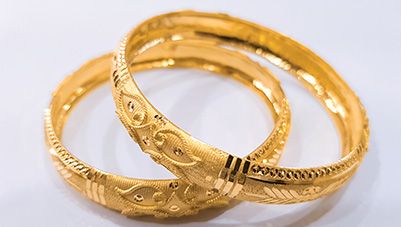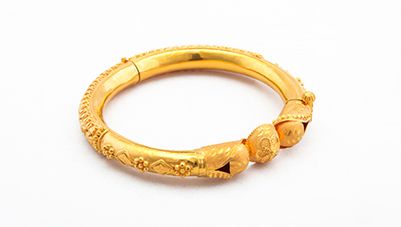Rs. 5,000 - Rs. 2 crore
To find the nearest gold loan branch,
Enter phone and OTP | Check amount you can get | Apply for quick funds
Understanding 22k gold making charges
When you buy 22-carat gold jewellery, the price you pay isn’t just for the gold itself. Making charges are extra costs that jewellers add for crafting the piece. These charges cover things like labour, intricate designs, and other expenses involved in creating the jewellery. Usually, they are calculated as a percentage of the gold’s weight or value, though some jewellers may charge a fixed amount.
Knowing about 22k gold making charges is important because they can significantly affect the total cost. These charges can differ between jewellers and locations, depending on factors such as the craftsmanship, brand, and complexity of the design. Always ask about making charges upfront to avoid surprises and make an informed purchase.
Key factors influencing 22k gold making charges
Several key factors influence 22k gold making charges, which can lead to substantial variations in the final cost of gold jewellery. The primary factor is the complexity of the design; intricate and detailed pieces require more time and skill, resulting in higher making charges. Labour costs also play a significant role, as regions with higher labour rates will naturally have higher making charges.
The brand reputation of the jeweller can impact the charges as well, with well-established brands often commanding premium prices for their craftsmanship and quality assurance. Additionally, seasonal demand and market trends can influence making charges, with peak seasons like weddings and festivals often seeing increased rates. Lastly, the use of additional materials such as gemstones or enamel work can elevate the making charges due to the added complexity and cost involved in incorporating these elements into the jewellery design.
How 22k gold making charges are determined?
The determination of 22k gold making charges involves a combination of several factors that collectively influence the final amount a buyer pays for the jewellery. Primarily, these charges are calculated based on the complexity of the design and the craftsmanship required to create the piece. Jewellers often assess the amount of time and skill needed to complete a design, which directly impacts the making charges.
Additionally, the reputation and brand of the jeweller can affect the charges, with renowned brands typically charging more for their perceived quality and exclusivity. Labour costs in the region also play a crucial role, as areas with higher labour rates will have correspondingly higher making charges. Seasonal demand and current market trends can further influence the charges, with higher demand periods often seeing an increase in the making costs. Lastly, the inclusion of additional materials such as gemstones or intricate enamel work can lead to higher making charges.
Pro tip: Got gold jewellery lying idle? Put it to work—check your gold loan eligibility and unlock its true value today.
How are 22 carat gold making charges calculated?
Calculating 22 carat gold making charges involves a systematic approach where jewellers consider various factors to arrive at the final cost. Typically, these charges are expressed as a percentage of the gold's price, which can range from 5% to 25% or more, depending on the design complexity and craftsmanship involved. For example, a simple gold chain may have lower making charges compared to an intricate necklace with detailed patterns and gemstone settings.
Some jewellers might also opt for a fixed rate per gram of gold. Labour costs, which vary by region, significantly impact the making charges, as does the jeweller's brand reputation. Additional costs may include the use of supplementary materials like gemstones or enamelling, which add to the complexity and time required to create the piece. Buyers need to understand these calculations to make informed decisions and ensure they are getting value for their money.
Design complexity and 22 karat gold making charges
The complexity of a jewellery design is a major determinant of the making charges for 22kt gold. Intricate designs require a high level of skill and significant time investment from the craftsmen, which translates into higher making charges. Simple designs such as plain bands or basic chains typically have lower making charges because they are easier and quicker to produce. On the other hand, elaborate pieces with detailed engravings, filigree work, or the inclusion of gemstones demand more labour and precision, thereby increasing the making costs.
Additionally, the tools and techniques used to create complex designs can also add to the overall charges. Jewellers must account for the expertise required to execute such designs flawlessly, ensuring the finished product meets high standards of craftsmanship and durability. As a result, customers seeking unique and intricate jewellery pieces should expect to pay higher making charges compared to those opting for simpler designs.
Impact of 22 karat gold making charges on gold loan
The making charges of 22 karat gold do not significantly impact the value of a loan against gold. When applying for a gold loan, lenders typically assess the gold’s purity and weight to determine its value. However, making charges are generally not considered in this evaluation, meaning the borrower does not receive compensation for the additional cost paid for the craftsmanship of the jewellery. This can result in a lower loan amount compared to the original purchase price of the gold item.
For example, if a piece of jewellery has high making charges due to its intricate design, these costs are not factored into the gold loan rate offered by the lender. Consequently, borrowers might receive a loan amount that is less than anticipated, based purely on the gold's intrinsic value rather than the total price paid, including making charges. Borrowers must understand this aspect when considering a loan against gold.
Evaluating 22 carat gold jewellery for loans
When evaluating 22 carat gold jewellery for loans, several key factors come into play to determine the amount that can be borrowed. The primary consideration is the purity of the gold, with 22 carats being a high standard that assures lenders of its value. The weight of the gold is also a crucial factor, as it directly influences the loan amount; heavier pieces will typically yield higher loans.
Lenders will usually have a set gold loan rate, which is applied to the current market value of 22 carat gold to calculate the loan offer. It is important to note that the making charges, which were paid during the purchase of the jewellery, are not considered in this evaluation. Therefore, the appraisal focuses solely on the gold content. Borrowers should ensure their gold is certified and properly documented to facilitate the evaluation process and secure a loan against gold with favourable terms.
Wondering how much you can borrow on your gold? Just check your gold loan eligibility—it takes seconds and minimal paperwork!
Related Articles
Disclaimer
Bajaj Finance Limited has the sole and absolute discretion, without assigning any reason to accept or reject any application. Terms and conditions apply*.
For customer support, call Personal Loan IVR: 7757 000 000









 Personal Loan
Personal Loan Check Eligibility
Check Eligibility Salaried Personal Loan
Salaried Personal Loan EMI Calculator
EMI Calculator Account Aggregator
Account Aggregator Credit Pulse Report
Credit Pulse Report
 Deals starting @99
Deals starting @99 Min. 50% off
Min. 50% off
 Bajaj Pay
Bajaj Pay Wallet to Bank
Wallet to Bank
 Easy EMI Loan
Easy EMI Loan Savings Offer
Savings Offer Smartphones
Smartphones Led TVs
Led TVs Washing Machines
Washing Machines Laptops
Laptops Refrigerators
Refrigerators Air Conditioner
Air Conditioner Air Coolers
Air Coolers
 Loan Against Shares
Loan Against Shares Loan Against Mutual Funds
Loan Against Mutual Funds Loan Against Insurance Policy
Loan Against Insurance Policy ESOP Financing
ESOP Financing Easy EMI Loan
Easy EMI Loan Two-wheeler Loan
Two-wheeler Loan Loan for Lawyer
Loan for Lawyer Industrial Equipment Finance
Industrial Equipment Finance Industrial Equipment Balance Transfer
Industrial Equipment Balance Transfer Industrial Equipment Refinance
Industrial Equipment Refinance Personal Loan Branch Locator
Personal Loan Branch Locator Used Tractor Loan
Used Tractor Loan Loan Against Tractor
Loan Against Tractor Tractor Loan Balance Transfer
Tractor Loan Balance Transfer Flexi
Flexi View All
View All
 Two-wheeler Loan
Two-wheeler Loan Bike
Bike Scooter
Scooter Electric Vehicle
Electric Vehicle Best Sellers
Best Sellers Popular Brands
Popular Brands

 Trading Account
Trading Account Open Demat Account
Open Demat Account Margin Trading Financing
Margin Trading Financing Share Market
Share Market Invest in IPO
Invest in IPO All stocks
All stocks Top gainers
Top gainers Top losers
Top losers 52 week high
52 week high 52 week low
52 week low Loan against shares
Loan against shares
 Home Loan
Home Loan Transfer your existing Home loan
Transfer your existing Home loan Loan against Property
Loan against Property Home Loan for Salaried
Home Loan for Salaried Home loan for self employed
Home loan for self employed Loan Against Property Balance Transfer
Loan Against Property Balance Transfer Home Loan EMI Calculator
Home Loan EMI Calculator Home Loan eligibility calculator
Home Loan eligibility calculator Home Loan balance transfer
Home Loan balance transfer View All
View All
 Term Life Insurance
Term Life Insurance ULIP Plan
ULIP Plan Savings Plan
Savings Plan Family Insurance
Family Insurance Senior Citizen Health Insurance
Senior Citizen Health Insurance Critical Illness Insurance
Critical Illness Insurance Child Health Insurance
Child Health Insurance Pregnancy and Maternity Health Insurance
Pregnancy and Maternity Health Insurance Individual Health Insurance
Individual Health Insurance Low Income Health Insurance
Low Income Health Insurance Student Health Insurance
Student Health Insurance Group Health Insurance
Group Health Insurance Retirement Plans
Retirement Plans Child Plans
Child Plans Investment Plans
Investment Plans
 Business Loan
Business Loan Secured Business Loan
Secured Business Loan Loan against property
Loan against property Loans against property balance transfer
Loans against property balance transfer Loan against shares
Loan against shares Home Loan
Home Loan Loans against mutual funds
Loans against mutual funds Loan against bonds
Loan against bonds Loan against insurance policy
Loan against insurance policy
 Apply for Gold Loan
Apply for Gold Loan Transfer your Gold Loan with Us
Transfer your Gold Loan with Us Gold Loan Branch Locator
Gold Loan Branch Locator
 ULIP Plan
ULIP Plan Savings Plan
Savings Plan Retirement Plans
Retirement Plans Child Plans
Child Plans Free Demat Account
Free Demat Account Invest in Stocks
Invest in Stocks Invest in IPO
Invest in IPO Margin Trading Facility
Margin Trading Facility Fixed Deposit Branch Locator
Fixed Deposit Branch Locator
 Check your Credit Score
Check your Credit Score
 New Car Loan
New Car Loan Used Car Loan
Used Car Loan Loan Against Car
Loan Against Car Car Loan Balance Transfer and Top-up
Car Loan Balance Transfer and Top-up My Garage
My Garage
 Get Bajaj Prime
Get Bajaj Prime
 Mobiles on EMI
Mobiles on EMI Electronics on EMI Offer
Electronics on EMI Offer  Iphone on EMI
Iphone on EMI LED TV on EMI
LED TV on EMI Refrigerator on EMI
Refrigerator on EMI Laptop on EMI
Laptop on EMI Kitchen appliances on EMI
Kitchen appliances on EMI Washing machines
Washing machines
 Personal Loan EMI Calculator
Personal Loan EMI Calculator Personal Loan Eligibility Calculator
Personal Loan Eligibility Calculator Home Loan EMI Calculator
Home Loan EMI Calculator Home Loan Eligibility Calculator
Home Loan Eligibility Calculator Good & Service Tax (GST) Calculator
Good & Service Tax (GST) Calculator Flexi Day Wise Interest Calculator
Flexi Day Wise Interest Calculator Flexi Transaction Calculator
Flexi Transaction Calculator Secured Business Loan Eligibility Calculator
Secured Business Loan Eligibility Calculator Fixed Deposits Interest Calculator
Fixed Deposits Interest Calculator Two wheeler Loan EMI Calculator
Two wheeler Loan EMI Calculator New Car Loan EMI Calculator
New Car Loan EMI Calculator Used Car Loan EMI Calculator
Used Car Loan EMI Calculator All Calculator
All Calculator Used Tractor Loan EMI Calculator
Used Tractor Loan EMI Calculator
 Hot Deals
Hot Deals Clearance Sale
Clearance Sale Kitchen Appliances
Kitchen Appliances Tyres
Tyres Camera & Accessories
Camera & Accessories Mattresses
Mattresses Furniture
Furniture Watches
Watches Music & Audio
Music & Audio Cycles
Cycles Mixer & Grinder
Mixer & Grinder Luggage & Travel
Luggage & Travel Fitness Equipment
Fitness Equipment Fans
Fans
 Personal Loan for Doctors
Personal Loan for Doctors Business loan for Doctors
Business loan for Doctors Home Loan
Home Loan Secured Business Loan
Secured Business Loan Loan against property
Loan against property Secured Business Loan Balance Transfer
Secured Business Loan Balance Transfer Loan against share
Loan against share Gold Loan
Gold Loan Medical Equipment Finance
Medical Equipment Finance
 Smart Hub
Smart Hub ITR Service
ITR Service Digi Sarkar
Digi Sarkar
 Savings Offer
Savings Offer Easy EMI
Easy EMI Offer World
Offer World 1 EMI OFF
1 EMI OFF New Launches
New Launches Zero Down Payment
Zero Down Payment Clearance Sale
Clearance Sale Bajaj Mall Sale
Bajaj Mall Sale
 Mobiles under ₹20,000
Mobiles under ₹20,000 Mobiles under ₹25,000
Mobiles under ₹25,000 Mobiles under ₹30,000
Mobiles under ₹30,000 Mobiles under ₹35,000
Mobiles under ₹35,000 Mobiles under ₹40,000
Mobiles under ₹40,000 Mobiles under ₹50,000
Mobiles under ₹50,000
 Articles
Articles
 Overdue Payments
Overdue Payments Other Payments
Other Payments
 Document Center
Document Center Bank details & Documents
Bank details & Documents Tax Invoice Certificate
Tax Invoice Certificate
 Do Not Call Service
Do Not Call Service
 Hamara Mall Orders
Hamara Mall Orders

 Fixed Deposit (IFA) Partner
Fixed Deposit (IFA) Partner Loan (DSA) Partner
Loan (DSA) Partner Debt Management Partner
Debt Management Partner EMI Network Partner
EMI Network Partner Became a Merchant
Became a Merchant Partner Sign-in
Partner Sign-in
 Trade directly with your Demat A/c
Trade directly with your Demat A/c ITR
ITR My Garage
My Garage
 Live Videos - Beta
Live Videos - Beta
 Savings Offer
Savings Offer Smartphones
Smartphones LED TVs
LED TVs Washing Machines
Washing Machines Laptops
Laptops Refrigerators
Refrigerators Air Conditioners
Air Conditioners Air Coolers
Air Coolers Water Purifiers
Water Purifiers Tablets
Tablets Kitchen Appliances
Kitchen Appliances Mattresses
Mattresses Furniture
Furniture Music and Audio
Music and Audio Cameras & Accessories
Cameras & Accessories Cycle
Cycle Watches
Watches Tyres
Tyres Luggage & Travel
Luggage & Travel Fitness Equipment
Fitness Equipment Tractor
Tractor Easy EMI Loan
Easy EMI Loan
 vivo Mobiles
vivo Mobiles OPPO Mobiles
OPPO Mobiles Xiaomi Mobiles
Xiaomi Mobiles Sony LED TVs
Sony LED TVs Samsung LED TVs
Samsung LED TVs LG LED TVs
LG LED TVs Haier LED TVs
Haier LED TVs Godrej Refrigerators
Godrej Refrigerators Voltas Washing Machines
Voltas Washing Machines
 New Tractor Loan
New Tractor Loan Used Tractor Loan
Used Tractor Loan Loan Against Tractor
Loan Against Tractor Tractor Loan Balance Transfer
Tractor Loan Balance Transfer
 New Car Loan
New Car Loan New Cars Under ₹10 Lakh
New Cars Under ₹10 Lakh New Cars – ₹10–₹15 Lakh
New Cars – ₹10–₹15 Lakh New Cars – ₹15–₹20 Lakh
New Cars – ₹15–₹20 Lakh New Cars – ₹20–₹25 Lakh
New Cars – ₹20–₹25 Lakh New Car Brands
New Car Brands Petrol – New Cars
Petrol – New Cars Diesel – New Cars
Diesel – New Cars Electric – New Cars
Electric – New Cars CNG – New Cars
CNG – New Cars Hybrid – New Cars
Hybrid – New Cars









